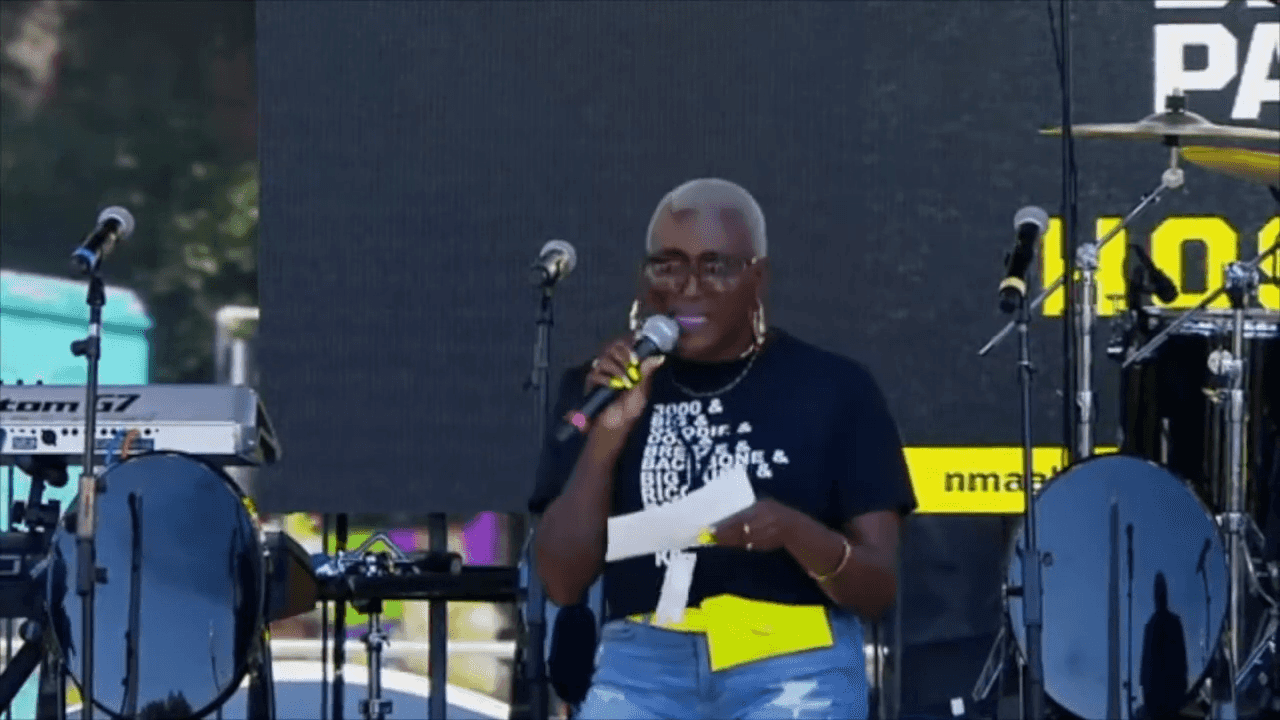Hip-Hop
Origins
From the Bronx to LA
Hip-hop started with parties in the Bronx and has grown to a level of worldwide recognition and influence that institutions like the National Museum of African American History and Culture collect hip-hop artifacts and memorabilia.

Our Hip-Hop Collection
From the earliest days of the National Museum of African American History and Culture in 2009, one thing was clear—hip-hop would be included. Though we started with nothing, the Hip-Hop Collection now includes over 300 objects: equipment, clothing, jewelry, photographs, manuscripts, albums, cassettes, CDs, poetry journals, handwritten lyrics and notes, flyers and promotional materials, and much more—ranging from the 1970s to the 2000s. This exhibition showcases both early and recent acquisitions and includes never-before shared objects featured in the Musical Crossroads exhibition and publication. Take a journey across the country as we explore hip-hop through its stories and objects.
Collecting Hip-Hop
Kurtis Blow’s Jacket
The National Museum of African American History and Culture collects and displays diverse historical materials that demonstrate hip-hop’s musical reach and its intersections within the museum’s political, social, cultural, and historical narratives. Whether taking a picture in front of a Public Enemy banner in the history exhibitions, deciphering handwritten notes on the “Ladies First” track sheet in Musical Crossroads, or exploring hip-hop's musical futures in Afrofuturism: A History of Black Futures, you can sample hip-hop’s material culture throughout the museum’s exhibitions.

East Coast: “NY State of Mind”
Chuck D’s Handwritten Lyrics
Born in New York City in the early 1970s, hip-hop reflects the influence of African American, Afro-Caribbean, and Afro-Latino traditions that came together after World War II. In the face of widespread poverty, police brutality, and other social pressures, hip-hop offered New York’s Black and Latino youth a form of grassroots creative expression.
As an innovative, do-it-yourself youth culture, hip-hop reflects the principle of “making a way out of no way” that has remained important throughout African American history. The first generations of East Coast hip-hop artists used the mundane elements of inner-city life such as neighborhood parties, subways, and clothing as inspiration for MCing and DJing, graffiti, and breaking (also known as breakdancing). New MCs and DJs drew on older traditions like funk, disco, spoken word, and Jamaican toasting to create the vibrant and distinctive genre of hip-hop.


West Coast: “California Love”
J. J. Fad Jacket
The roots of West Coast hip-hop include the post-World War II migration of African Americans to West Coast cities, the legacy of the Black Panther Party, and the work of poets like the Watts Prophets in the 1960s and 1970s. Los Angeles, the San Francisco Bay Area, and other West Coast communities developed distinctive approaches to hip-hop music that became internationally influential.
West Coast hip-hop began to develop in the late 1970s through the music of popular Los Angeles-based DJs like Alonzo Williams, organizer of the popular band World Class Wreckin’ Cru. Beginning in the mid-1980s, Los Angeles hip-hop became associated with “gangsta” rap, known for gritty descriptions of inner-city life, and G-funk, a production style pioneered by Dr. Dre that drew heavily on the work of funk artists like George Clinton. Bay Area hip-hop also developed in the 1980s and was strongly influenced by the Oakland funk scene. Seattle’s hip-hop community became prominent in the 1990s through the work of Sir Mix-A-Lot and Ishmael “Butterfly” Butler of Digable Planets.


South: “Southern Hospitality”
Poster from Charlotte, NC
Beginning in the 1970s and continuing into the 21st century, southern cities like Atlanta and Houston and areas like North Carolina’s Research Triangle have attracted Black migrants from the urban North and Midwest. This “reverse Great Migration” has helped to re-establish the South as an influential center of African American culture. Growing Black communities in the South have also developed unique variations on hip-hop that became especially influential in the early 2000s.
Miami and Houston were the first southern cities to make a nationwide impact on hip-hop culture. The 1980s commercial success of subgenres like Miami bass and hip-hop groups like The Geto Boys and 2 Live Crew helped to raise southern hip-hop’s profile. In the early 1990s, Atlanta-based groups like Outkast and Goodie Mob turned Georgia’s “Black Mecca” into a hub for hip-hop culture. Other southern Black communities, such as Virginia Beach, Memphis, and New Orleans also made influential contributions to hip-hop beginning in the 1990s.


Midwest: “Midwest Swing”
J Dilla’s MPC
Midwestern cities have been hubs of Black popular music for more than a century. Cities like Chicago, Detroit, Minneapolis, and Cleveland were key destinations in the Great Migration of African Americans from the South to cities in the Northeast, Midwest, and West. Hip-hop began to flourish in the Midwest in the early 1980s.
Midwestern hip-hop is eclectic, sometimes reflecting earlier regional traditions such as Chicago house music or Dayton funk. The first hip-hop artists from the Midwest to achieve national commercial success were Flint, Michigan-based MC Breed and DFC, whose “Ain’t No Future in Yo’ Frontin’” was a hit single in 1991. Midwestern hip-hop styles that appeared in the following decades included chopping, a rapid-fire rapping style, and drill, a Chicago subgenre featuring minimalistic production and stark depictions of inner-city life. Other Midwestern hip-hop artists adopted a “conscious” style, drawing on the Midwest’s long history of spoken word performance and Black political activism.

The Story Continues
Smithsonian Anthology of Hip-Hop and Rap
In 2021, The National Museum of African American History and Culture, in partnership with Smithsonian Folkways Recordings, released the Smithsonian Anthology of Hip-Hop and Rap, a first-of-its-kind collection chronicling hip-hop’s growth and impact. The collection includes 129 tracks on 9 CDs, a 300–page book designed by Cey Adams, essays by some of hip-hop’s leading writers and critics, and hundreds of photographs spanning decades of hip-hop history. The Smithsonian Anthology of Hip-Hop and Rap reveals the many faces of this multifaceted genre, its social and political implications, and its influence on popular culture.

The origins of hip-hop and rap rest in the community where people gathered together in basements, on street corners, neighborhood dance parties, and community shows to tell the stories of the people and places that brought it to life in a language all its own.
Dr. Dwandalyn Reece, 2022
Featured Video
Hip-Hop Block Party: Panel Discussion
During the 2022 Hip-Hop Block Party, Jeff Chang moderated this conversation with Bun B, Roxanne Shanté, and Chuck D. They discussed hip-hop's history and cultural impact with Dr. Dwandalyn Reece and Timothy Anne Burnside of the National Museum of African American History and Culture.
